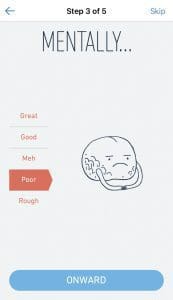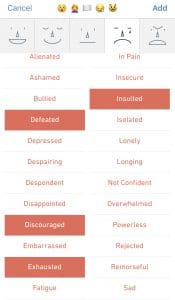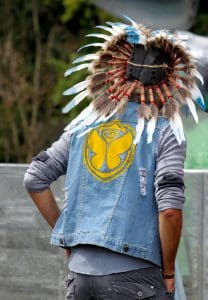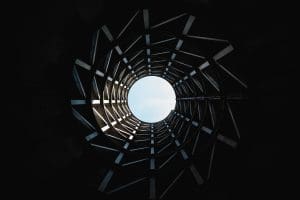
An App to Consider: Stop, Breathe & Think
June 28, 2019 in LINKS
Stop, Breathe and Think, like other mindfulness apps, helps those take a few minutes out of their day to check in with themselves, and as the title suggests, stop, breathe, and think. Unlike most apps is that it’s incredibly customizable, taking in how you’re feeling and building activities that they think is best for you.
The app lets you determine how you’re feeling at that moment both physically
and mentally, then has you choose five feelings that you’re currently experiencing (each have their own emoji representing them too!). From there, they give a recommended list of activities for you to try for a bit, but you can always explore all the activities if the ones they suggest aren’t right for you. You aren’t limited to this list forever either; every time you check-in to see how you’re doing, SBT will give you a new list if how you’re feeling is different than before.
What also truly makes SBT stand out is its corresponding app made for kids between the ages of 5-10. If you have a younger sibling, cousin, or family friend, just to name a few, SBT for Kids may help them gain mindfulness and social-emotional learning (SEL skills). SEL skills are a part of understanding and being strong in emotional intelligence, that is, having more SEL skills helps people understand and process their emotions in a healthy way, and it also helps those understand how others are feeling and makes them more empathetic. The kids’ version includes games and activities that are developmentally appropriate – some of the games require movement, for example, to build up their motor skills.
Because of this, SBT for Kids works as a kind of early intervention (an intervention made to help protect those from issues they may be vulnerable to from happening, such as mental illness). That doesn’t mean that if you’re not under 10 years old that you’re doomed for life because you didn’t develop SEL skills like this when you were younger. Those even in adolescence can practice and learn about mindfulness and SEL, and it’d still be early enough for them to reduce the severity of certain things, like the more dangerous effects of mental illness and the snowball effects that can result.
Do you use mindfulness apps? What do you think about the customizable experience? What do you think about the idea of a mindfulness app for children?









 Walk-and-talk therapy is just that: walking and talking. After an initial consultation that’s done more traditionally indoors, walk-and-talk therapy sessions occur, of course, outside, going on trails, sidewalks, and are just like your regular walks you would have with your friends, but the conversations are focused on your well-being and mental health and completed with your therapist.
Walk-and-talk therapy is just that: walking and talking. After an initial consultation that’s done more traditionally indoors, walk-and-talk therapy sessions occur, of course, outside, going on trails, sidewalks, and are just like your regular walks you would have with your friends, but the conversations are focused on your well-being and mental health and completed with your therapist.  You may also feel like you have to have something to say during sessions, which can lead to an awkward silence as you collect your thoughts or even try to come up with something to talk about, but walking around removes that, because both you and your therapist are doing something else by walking and taking in what’s going on outside. Walking outside also includes visuals that can help inspire ideas for you to talk about.
You may also feel like you have to have something to say during sessions, which can lead to an awkward silence as you collect your thoughts or even try to come up with something to talk about, but walking around removes that, because both you and your therapist are doing something else by walking and taking in what’s going on outside. Walking outside also includes visuals that can help inspire ideas for you to talk about.
 struggle. There are so many YouTubers and singers that have spoke a lot about their struggles with mental health, and I feel as though knowing of celebrities that talk openly about their own personal struggles can help teenagers suffering with similar things.
struggle. There are so many YouTubers and singers that have spoke a lot about their struggles with mental health, and I feel as though knowing of celebrities that talk openly about their own personal struggles can help teenagers suffering with similar things.


 Summer is officially in full swing. Even though the season formally started on Friday, it may feel like it’s been that way for a while now if you’ve recently finished the school year or noticed just how hot and muggy it’s been.
Summer is officially in full swing. Even though the season formally started on Friday, it may feel like it’s been that way for a while now if you’ve recently finished the school year or noticed just how hot and muggy it’s been. is often associated with positivity because of the longer hours in the day and sunlight, but it can also be a crankier time as the temperatures continue to rise.
is often associated with positivity because of the longer hours in the day and sunlight, but it can also be a crankier time as the temperatures continue to rise.  That doesn’t mean you can’t enjoy the warmth though. If you want your summer to be as pleasant as it can be and you want to have some control over your mood, there are tons of ways to keep cool beyond feeling like you need to stay cooped inside all day with air conditioning. It’s important to stay hydrated – not just by drinking water, but through things like misting sprays (there are even some that are combined with fans to help keep you extra cool!). Cooling towels are usually associated with sports, but you can also keep them with you when you’re outside, especially if it’s so hot that you sweat the second you’re exposed to the sun.
That doesn’t mean you can’t enjoy the warmth though. If you want your summer to be as pleasant as it can be and you want to have some control over your mood, there are tons of ways to keep cool beyond feeling like you need to stay cooped inside all day with air conditioning. It’s important to stay hydrated – not just by drinking water, but through things like misting sprays (there are even some that are combined with fans to help keep you extra cool!). Cooling towels are usually associated with sports, but you can also keep them with you when you’re outside, especially if it’s so hot that you sweat the second you’re exposed to the sun.

















Recent Comments